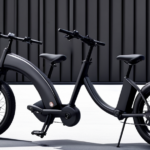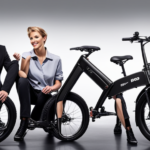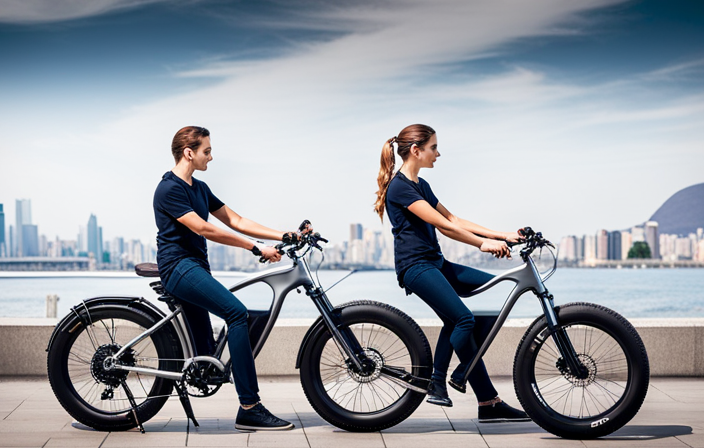As I hop on my electric bike for another adventurous ride, I can’t help but marvel at the convenience of foldable pedals. With just a simple flick of a switch, these nifty contraptions can be neatly tucked away, saving precious space and making transportation a breeze.
In this article, I will guide you through the step-by-step process of folding your electric bike pedals, ensuring a seamless and efficient experience. So let’s dive in and unlock the secrets of this ingenious folding mechanism.
Key Takeaways
- Grasp the pedal firmly and release the locking mechanism to fold it.
- Fold the pedal towards the bike frame until it clicks into place.
- To unfold the pedal, reverse the process and lock it in the extended position.
- Proper maintenance and care, including regular cleaning and lubrication, are important for the longevity of foldable pedals.
Understand the Purpose of Folding Pedals
Understanding the purpose of folding pedals is important for learning how to fold them on an electric bike. Foldable pedals offer several benefits when compared to regular pedals.
Firstly, they provide convenience by allowing the bike to be more compact and easier to store or transport. This is particularly useful for those who have limited storage space or frequently travel with their electric bike.
Secondly, foldable pedals can help prevent damage or scratches to the bike or other items when the pedals are folded in.
When choosing the right foldable pedals for your electric bike, consider factors such as the material, size, and weight. Ensure that the pedals are sturdy enough to withstand the weight and pressure exerted during cycling.
With a clear understanding of the purpose and the right choice of foldable pedals, you are now ready to gather the necessary tools for folding the pedals.
Gather the Necessary Tools
First, you’ll need to grab the required tools for the task at hand. To ensure a smooth folding process, it’s essential to have the right tools at your disposal. Here’s a list of items you’ll need:
- Allen wrench set: This will allow you to loosen and tighten bolts with precision.
- Adjustable wrench: Ideal for adjusting various components on your electric bike.
- Lubricating oil: Applying lubrication to the folding mechanisms will prevent rust and ensure smooth operation.
- Cleaning cloth: Keep your folding mechanisms clean and free from debris for optimal performance.
Understanding folding mechanisms is crucial when it comes to folding pedals on your electric bike. By familiarizing yourself with the specific folding mechanism of your bike, you can ensure a successful folding process.
Now, let’s move on to locating the folding mechanism on your electric bike.
Locate the Folding Mechanism on Your Electric Bike
Now, let’s find where the folding mechanism is on your e-bike.
The electric bike folding mechanism is a crucial component that allows for easy and convenient folding of the bike. Typically, the folding mechanism is located near the center of the frame, close to the pedal area. It is important to familiarize yourself with the specific location and operation of the folding mechanism on your particular e-bike model.
One of the advantages of folding pedals is that they can make the folding process even more compact and streamlined. By folding the pedals, you can reduce the overall width of the folded bike, making it easier to store and transport.
Now that we know where the folding mechanism is, let’s move on to the next step of preparing your bike for folding.
Prepare Your Bike for Folding
To get your e-bike ready for folding, start by checking the frame for any loose components. Ensure that all bolts and screws are properly tightened to prevent any potential issues during the folding process.
Once you have confirmed the stability of the frame, you can proceed to fold the pedals. Folding the pedals is an important step in preparing your bike for folding, as it helps to reduce the overall size and make it more compact. By folding the pedals, you can easily fit your e-bike into smaller spaces, such as car trunks or storage areas.
To fold the pedals, simply rotate them towards the bike frame until they are parallel. This technique allows for a secure and streamlined folding process.
Now that the pedals are folded, you can move on to releasing the locking mechanism, which will be discussed in the next section.
Release the Locking Mechanism
Once you’ve ensured the stability of your e-bike frame and folded the pedals, it’s time to release the locking mechanism.
The purpose of the locking mechanism is to securely hold the bike in its folded position, preventing any accidental unfolding during transportation or storage. To release the locking mechanism, locate the latch or lever near the hinge of the frame and push or pull it, depending on the design.
Once the locking mechanism is released, you can proceed to fold the pedals towards the bike frame. The benefits of folding pedals are twofold: first, it reduces the overall width of the bike, making it more compact for storage or transport; second, it eliminates the risk of the pedals getting tangled or damaged during transit.
Now, let’s move on to the next step of folding the pedals towards the bike frame.
Fold the Pedals Towards the Bike Frame
After releasing the locking mechanism, you can proceed to fold the pedals towards the frame. Foldable pedals offer several benefits, such as increased portability and convenience during transportation or storage.
To fold the pedals, first, locate the foldable mechanism near the pedal axle. Gently push or pull the pedal until it folds towards the bike frame. Ensure that the pedal is securely folded to prevent any accidental unfolding during use.
Folding the pedals not only saves space but also protects them from damage. It is important to follow the manufacturer’s instructions for folding the pedals, as different bike models may have varying folding techniques.
Once the pedals are folded, you can move on to securing them in place for added safety and stability.
Secure the Folded Pedals in Place
Ensure that the folded pedals are securely fastened to maintain stability while riding. To secure the folded pedals properly, follow these steps:
- Use the locking mechanism provided by the manufacturer to secure the folded position of the pedals.
- Check that the locking mechanism is engaged correctly and that the pedals are firmly held in place.
- Give the pedals a gentle tug to ensure they are securely fastened and won’t come loose during your ride.
- Test the proper functioning of the folded pedals by rotating them and ensuring they move smoothly without any wobbling or play.
By taking these measures, you can guarantee the stability of the folded pedals and ensure your safety while riding.
Now, let’s move on to double-checking the stability of the folded pedals without repeating any previous instructions.
Double-Check the Stability of the Folded Pedals
To make sure the folded pedals are stable, give them a gentle shake to ensure they’re securely fastened and won’t come loose while riding.
Start by locating the folding mechanism on the bike frame. This is usually located near the crankset or bottom bracket area. Once you have located it, carefully fold the pedals towards the bike frame until they lock into place.
Ensure that the folding mechanism is fully engaged and that there are no loose parts or excessive play. Now, grab hold of the folded pedals and give them a gentle shake. You should feel no movement or hear any rattling noises.
If there is any instability or looseness, double-check the folding mechanism and make any necessary adjustments before proceeding to the next step of testing the folded pedals for proper functioning.
Test the Folded Pedals for Proper Functioning
After ensuring the stability of the folded pedals, it is crucial to test their functionality to identify any potential issues. Testing the folded pedals involves a series of steps aimed at troubleshooting any problems that may arise.
First, I recommend gently pushing down on each folded pedal to ensure that it locks securely into place.
Next, try unfolding the pedals and folding them back multiple times to check for any signs of stiffness or resistance. This will help identify any potential issues with the folding mechanism.
Additionally, it is essential to test the pedals while riding the electric bike to ensure that they function properly and do not hinder the overall performance.
By testing the functionality of the folded pedals, you can troubleshoot any issues before hitting the road.
Now, let’s move on to the next section and discuss how to practice folding and unfolding the pedals.
Practice Folding and Unfolding the Pedals
Practicing folding and unfolding the pedals is essential to familiarize yourself with the process and ensure smooth operation. By practicing these techniques, you can become more efficient in the folding process and reduce the chances of any mishaps.
When folding the pedals, make sure to grasp the pedal firmly and release the locking mechanism. Gently fold the pedal towards the bike frame until it clicks into place.
To unfold the pedals, simply reverse the process by releasing the locking mechanism and extending the pedal until it locks in its fully extended position.
The benefits of folding pedals include easy storage and transportation, especially when you need to fit your electric bike in a small space or carry it on public transportation. Considering using pedal straps or covers for added convenience can further enhance your experience. These accessories can help prevent the pedals from unfolding accidentally and protect them from damage during transit.
Consider Using Pedal Straps or Covers for Added Convenience
Using pedal straps or covers can make it easier to transport your electric bike and provide added convenience.
Pedal straps are adjustable straps that attach to your pedals, securing your feet in place while riding. They offer several benefits, including increased pedaling efficiency and improved control.
Pedal covers, on the other hand, are rubber or plastic covers that fit over your pedals, protecting them from damage and providing additional grip. These covers can also help prevent your feet from slipping off the pedals, especially in wet or slippery conditions.
When choosing pedal covers, consider options that are durable, lightweight, and easy to install and remove. Investing in pedal straps or covers can greatly enhance your riding experience and make it more convenient to transport your electric bike.
However, if you’re looking for alternative folding options for your pedals, let’s explore other possibilities.
Explore Other Folding Options for Pedals
Consider different ways to collapse the footrests for added convenience while transporting your e-bike. When it comes to folding pedals, there are alternative designs that offer benefits of folding. These designs allow you to easily fold the pedals, making your bike more compact and easier to store or transport. Let’s take a look at a comparison table showcasing four different folding options for pedals:
| Folding Option | Description |
|---|---|
| 1. Folding Platform Pedals | These pedals feature a hinged mechanism that allows the entire pedal platform to fold upwards, reducing the overall width of the bike. |
| 2. Folding Cage Pedals | With a folding hinge located at the center of the pedal cage, these pedals can be folded inwards, reducing the size of the pedals. |
| 3. Collapsible Pedal Arms | These pedals have detachable arms that can be collapsed, resulting in a more streamlined bike profile. |
| 4. Telescopic Pedals | Telescopic pedals feature adjustable lengths, allowing you to shorten the pedal length for easier storage. |
Learn Proper Maintenance and Care for Foldable Pedals
Taking care of your foldable pedals is crucial for maintaining their functionality and longevity. Proper maintenance and care will ensure that your foldable pedals continue to perform at their best and last for a long time. Here are some important steps to follow:
-
Regular cleaning: Remove any dirt or debris from the pedals using a soft brush or cloth. This will prevent the buildup of grime and keep the moving parts functioning smoothly.
-
Lubrication: Apply a small amount of lubricant to the moving parts of the pedals, such as the hinges and springs. This will reduce friction and prevent rusting.
-
Check for loose screws: Periodically inspect the pedals for any loose screws or bolts. Tighten them if necessary to ensure stability and safety.
-
Store properly: When not in use, fold the pedals and store them in a clean and dry place. Avoid exposing them to extreme temperatures or moisture.
By following these maintenance tips, you can ensure that your foldable pedals on your electric bike remain in top condition.
Now, let’s move on to sharing your folding pedal experience with others.
Share Your Folding Pedal Experience with Others
Have you shared your experience with others about using foldable pedals on your e-bike?
As a cyclist who frequently uses folding pedals, I have found them to be a game-changer in terms of convenience and portability.
When it comes to pedal maintenance, foldable pedals require regular cleaning and lubrication, just like regular pedals. However, the folding mechanism itself may need occasional tightening to ensure smooth operation.
If you’re looking for folding pedal alternatives, there are various options available, including quick-release pedals and pedals with removable platforms. These alternatives offer similar benefits to foldable pedals while catering to different preferences and needs.
Enjoy the Benefits of a Foldable Pedal System on Your Electric Bike
Using a foldable pedal system on your e-bike offers convenience and portability. Here are four key benefits of foldable pedals:
-
Space-saving: Foldable pedals can be easily folded up when not in use, reducing the overall size of your e-bike. This is particularly useful when storing or transporting your bike in tight spaces.
-
Easy storage: With foldable pedals, you can easily store your e-bike in smaller areas, such as closets or car trunks. This makes it more convenient for those living in apartments or with limited storage space.
-
Travel-friendly: Foldable pedals make it easier to take your e-bike on trips. You can quickly fold them up and pack your bike in a travel bag or box without worrying about the pedals taking up unnecessary space.
-
Versatility: Foldable pedals allow you to easily switch between riding with or without pedals. This is especially useful when using your e-bike as a scooter or when maneuvering through crowded areas.
Frequently Asked Questions
Can I use pedal straps or covers with foldable pedals?
Yes, it is possible to use pedal straps or covers with foldable pedals. However, it is important to ensure that the straps or covers do not interfere with the folding mechanism and compromise safety.
Are there any other folding options available for pedals?
Sure, there are alternative folding mechanisms for pedals. Different designs include quick-release pedals, folding platforms, and hinged pedals. Each has its pros and cons, such as ease of use, stability, and durability.
How can I properly maintain and care for foldable pedals?
To properly maintain and care for foldable pedals, I recommend following these cleaning techniques: use a soft brush to remove dirt and debris, wipe with a damp cloth, and apply lubricant. For storage solutions, keep them in a dry and secure place.
Can you share your experience with folding pedals on an electric bike?
My experience with electric bike folding pedal installation has been smooth sailing. I’ve found that following a few tips, such as ensuring proper alignment and securely tightening the bolts, can make the process quick and hassle-free.
What are the benefits of having a foldable pedal system on an electric bike?
The advantages of a foldable pedal system on an electric bike include increased portability and ease of storage. However, there are some disadvantages such as potential durability issues and the need for regular maintenance to ensure proper functionality.
Conclusion
As I conclude my journey into the world of folding pedals on electric bikes, I am reminded of the power of adaptability.
Just like the folding pedals symbolize the ability to transform and adjust, so too can we embrace change in our own lives.
By understanding the purpose and mechanics of folding pedals, we unlock a world of convenience and versatility.
With proper maintenance and care, we can ensure the longevity of our foldable pedal system.
So let us pedal forward, embracing the benefits and sharing our experiences with others, as we navigate the ever-changing paths of life.
















